|
Monday, December 8, 2008
Progress Notes
Last week I placed the following notice on this page:
ANNOUNCEMENT!
“The Miller County Museum is delighted to inform members and the public that the College of the Ozarks at Point Lookout, Missouri has made the decision to return to the community the old Tuscumbia Presbyterian Church Bell for permanent public display at our museum. The bell, weighing approximately 720 pounds, was brought to Tuscumbia by steamboat in 1889, the year the church was organized. In the late 1970’s the church was closed due to declining membership, one of the unfortunate consequences of the national phenomenon of rural population translocation to metropolitan areas. However, the board of elders of the church, desiring that the bell be preserved in an honorable manner, made arrangements with the College of the Ozarks at Point Lookout, Missouri (near Hollister/Branson area) to have the bell removed to the large museum on the college campus where it resides today. The local church had always been a faithful supporter of the College, which is a Presbyterian supported institution very well known for the inspiring mission of providing education to underprivileged young people, not only from Missouri but from the nation. The bell was rung for the last time by Elder Frank Martin on July 4, 1976, the date of the national sesquicentennial celebration honoring the Declaration of Independence. The bell could be heard as far away as three or four miles from Tuscumbia. Not long after that, the bell was removed and taken to Point Lookout. Soon, those who live in Tuscumbia and the surrounding hills and valleys once again will have opportunity to hear the bell ring, for it is returning home.”
Later I found an old newspaper article in the Eldon Advertiser dated December 17, 1981 which covered the story of the removal of the bell from the church (photo 01).
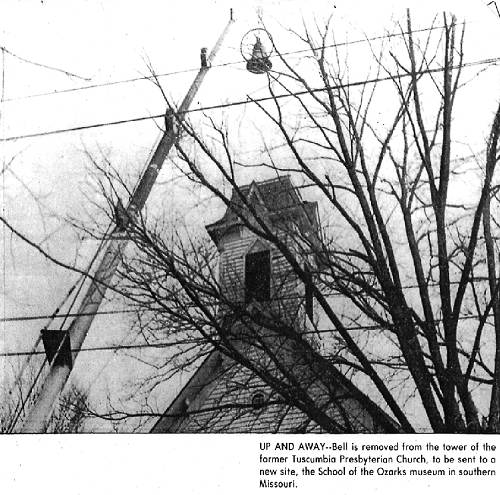
01 Presbyterian Church of Tuscumbia
Click image for larger view
Here is a copy of that article:
Church Bell Going to Museum
Eldon Advertiser
December 17, 1981
A church bell, which called the congregation to services in Tuscumbia for the first time more than 91 years ago, will go to a new location-the museum at School of the Ozarks, Point Lookout.
The 720 pound bell in the tower of the former Tuscumbia Presbyterian Church was removed last Thursday, December 3, to be sent to the new site.
The congregation had approved giving the bell and stained glass windows from the church building to the school on November 19, 1978, at which time the church in Tuscumbia became inactive. The stained glass windows were immediately removed and taken to the school.
The church building and real estate were sold to the present owner, Harold Mungold, Tuscumbia, by John Calvin Presbytery at Springfield.
The Tuscumbia Presbyterian Church building was dedicated on November 14, 1889 and the next spring received the bell which was removed last week.
A story in the Tuscumbia Autogram of June 5, 1890 tells of the bell’s arrival:
“Members of the Tuscumbia Presbyterian Church received their new bell on Saturday, and it was placed in position in the tower the same day, and the day following called the Sunday School members together for the first time. The bell is metal and weighs 720 pounds.”
Well, last week we went to the campus of the College of the Ozarks near at Point Lookout, Missouri to load the bell on a low boy trailer and take it back home to Tuscumbia (photo 02).
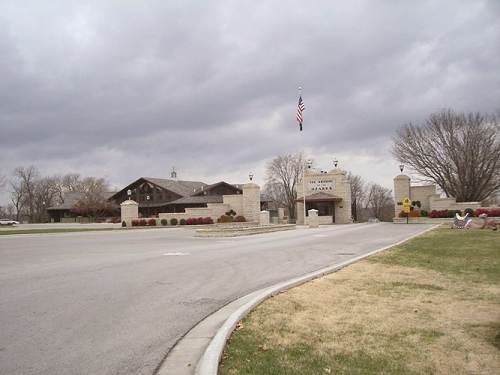
02 Entrance to College Campus
The history of the College of the Ozarks (originally known as the School of the Ozarks) is very interesting and heartwarming. It was started by a Presbyterian missionary named James Forsythe (photo 03) who, after being assigned to this area of the southern Missouri Ozarks, noticed a great lack of facilities for educating the young people who lived there.
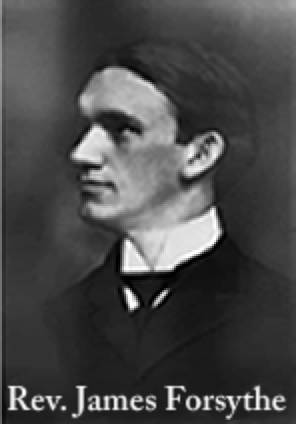
03 Reverend James Forsythe
He brought this need to the attention of the Missouri Synod of the Presbyterian Church and in 1906 his dream and mission were realized when the Synod organized and established the beginning of this now very famous and worthy institution of higher learning.
You can read more about the College of the Ozarks by referring to their website:
https://www.cofo.edu/Visit
A description of the College by President Jerry C. Davis:
“College of the Ozarks is unique among higher education institutions in America: no tuition is charged, all students work on campus each semester, debt is openly discouraged and no federal or state loans are made. Called “Hard Work U.” by The Wall Street Journal, deserving students are offered the advantages of a quality, Christian education.
Our institution has evolved from a high school to a thriving, four-year accredited institution that is committed to a five-fold mission of encouraging academic, Christian, cultural, vocational, and patriotic growth in its students. Starting as a tiny school on an Ozarks hill, the College has survived major fires, the Great Depression, wars, and struggles to be one of America’s finest—and most distinctive—institutions.
The College’s commitment to cultivating character and the work ethic and promoting Christian values has attracted renowned leaders such as President George Bush, Sr., President Gerald Ford, First Ladies Barbara Bush and Pat Nixon, Prime Minister of Great Britain Margaret Thatcher, and General Norman Schwarzkopf, among many others. While visiting the College, Lady Thatcher said, “The education that you get here is not only an education or a qualification for a degree; it is an education for life.”
Several Miller County students have attended the College in the past; presently Caitlyn Farris of Eldon has just begun her Freshman year at the College. Caitlyn was Valedictorian of the Eldon Senior Class last year and exemplifies the quality of student which the College accepts for its four year college level program. Students are accepted from all parts of the United States but most come from Missouri, Arkansas, Kansas and Oklahoma. The students are expected to work on the campus in exchange for their room and board and academic requirements. Much of the food consumed is grown on the College Farm which is worked by students. Others work in janitorial and maintenance positions as well as various positions of the service staff in the Keeter Center Restaurant. The College of the Ozarks is a completely self supported educational institution and depends on private donations for its existence. And after talking with a few students who live there, observing how excited and enthusiastic they are, one feels that hardly any better choice for charitable financial support could be found!
I strongly recommend to anyone a trip down to Point Lookout, Missouri near Branson/Hollister to visit the campus of this great school just to see for oneself how large it has become and the work it is doing. The enthusiasm of the students on campus is infectious and heartwarming. Upon entering the wide street entrance to the campus one cannot but help be impressed by the huge Keeter Center named in honor of members of the Keeter family who have been major supporters of the College for many years (photo 04).
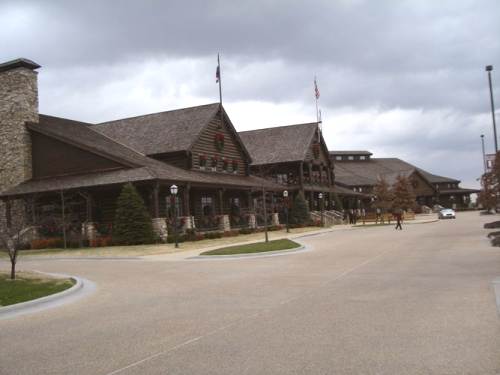
04 Keeter Center
It was at the lodge that we were met last week by Vice President Howell W. Keeter, who had made the arrangements for getting the bell ready for travel to Tuscumbia.
Dr. Keeter, who is a member of the Keeter family mentioned above, has devoted most of his career (thirty nine years) at the College helping underprivileged youth learn how to become successful based on the principles of persistence and hard work. Dr. Keeter is from Arkansas not too many miles south of the College but now lives near the campus. He taught for many years courses in mathematics but later after assuming administrative responsibilities earned his PhD in the field of education. He has devoted his life to the College, a service which was recognized a few years ago when the College built a new field house and in his honor named it Keeter Gymnasium. I found Dr. Keeter to be one of the most modest and kind individuals you will ever meet. He has his PhD but introduces himself by his first name, Howell, rather than “Doctor.” He told me to not dwell on his story but to emphasize the College and the great work it is doing to help underprivileged young people who have great potential but little opportunity due to financial circumstances.
It is such a wonderful coincidence that Dr. Keeter, who was the one who made it possible for us to return the old Church Bell to Tuscumbia, was also the representative from the College who came to Tuscumbia that day in 1981 to direct the removal of the bell from the church belfry in preparation for transporting it to the College. As I noted above in the announcement, the church elders back in 1981 knew the old bell was a very historical part of the church as well as Tuscumbia history so the elders were very grateful to the College for its willingness to receive and preserve the bell, not knowing that in the future, circumstances would present which would allow us to bring it home again. And now we are grateful once again to the College for allowing us to return the bell to its home. Dr. Keeter had arranged for the bell to be ready for loading on our trailer, which so kindly was loaned to us by Paul and Sharon Holder. Paul pulled the trailer down to Point Lookout and supervised the loading so that the bell would ride safely back to Tuscumbia. The College provided the staff and the heavy equipment necessary to load the heavy bell including a fork lift and front end loader. Next is a series of photos showing the loading of the bell (photos 05 - 08).
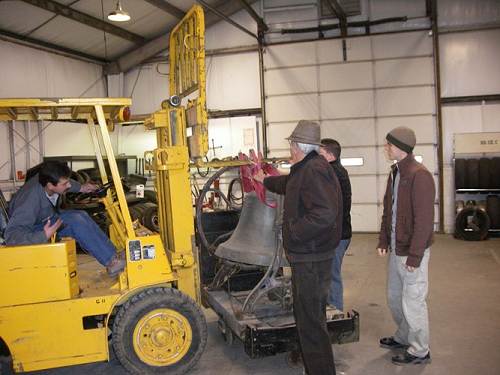
05 Dr. Keeter directing transfer of Bell
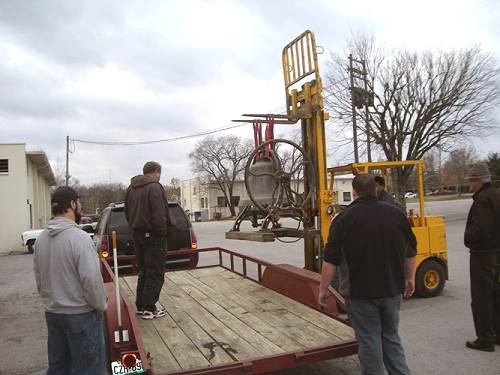
06 Paul Holder waiting to position Bell
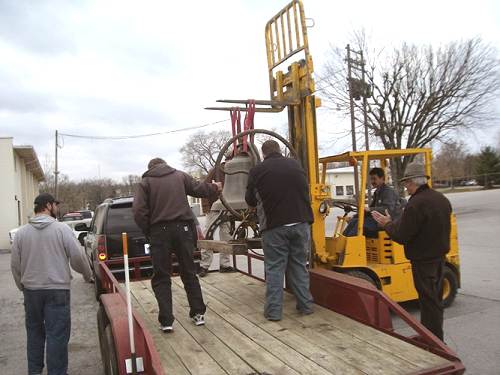
07 Paul and Dr. Keeter positioning Bell
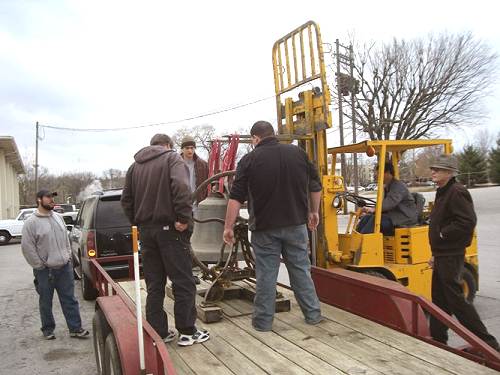
08 Bell positioned on trailer
Finally, I and Dr. Keeter posed in front of the bell just before it began its journey home (photo 09).
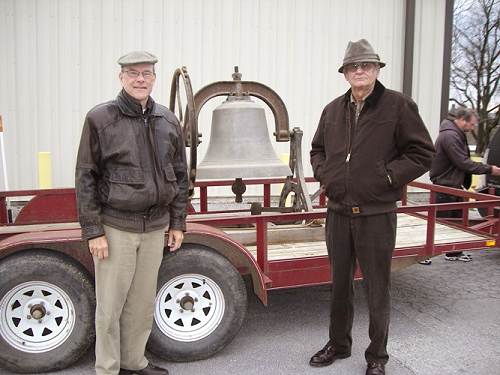
09 Myself and Dr. Keeter with loaded Bell
As we pulled out and left the campus I noticed a number of onlookers who seemed somewhat bemused to see this large old bell being towed away. We received some attention and questions by others when we stopped for gas too. I doubt that very many people have seen a huge 118 year old church bell up close; at least not “tooling” down the highway on a trailer! Upon arrival in Tuscumbia, I had the valuable help of board member Jim Clark who brought his tractor with front end loader to lift the old bell off the trailer and place it at our museum entrance (photo 10).
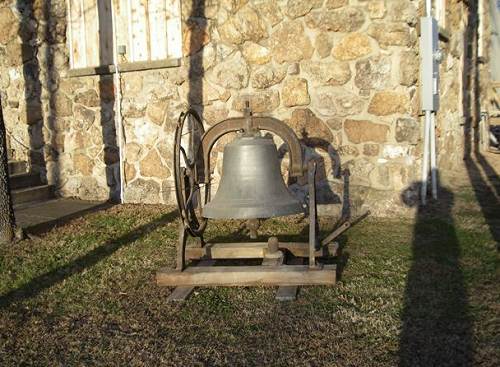
10 Presbyterian Church Bell arrives in Tuscumbia
We are going to build a small belfry to cover the bell but leave it outside the museum so that passersby can see it everyday as they drive by on Highway 52.
The College of the Ozarks is located on a high hill which overlooks the White River valley in which are found Table Rock and Taneycomo lakes. The view from the campus is spectacular. The well laid out campus features streets with inspirational names like Opportunity Ave. and Spiritual St.. Other signs encourage duty and work; in fact, that is one reason the Wall Street Journal article (to which Dr. Davis referred) above named the school “Hard Work University.”
The campus chapel is an impressively large stone structure adorned inside with beautifully stained windows.
The Keeter Center is a magnificent huge log building with three large sections (see photo 04 above). As I noted above, it is the first building you see on entering the campus.
The day we were there to receive the bell, Christmas decorations filled the entire lower level of the building. The Christmas tree was magnificent and I think the fireplace in the great room of the building is the tallest I have ever seen!
One of the enjoyable features of a visit to the campus is a tour of the Ralph Foster museum. Next week I will describe some of the history behind the museum and the man for whom it is named.
Now I want to include some history about the old bell. To begin with, the Tuscumbia Presbyterian Church, where the bell originally was located, was my home church growing up in Tuscumbia. Here is a photo showing the large belfry and steeple which held the bell (photo 15).
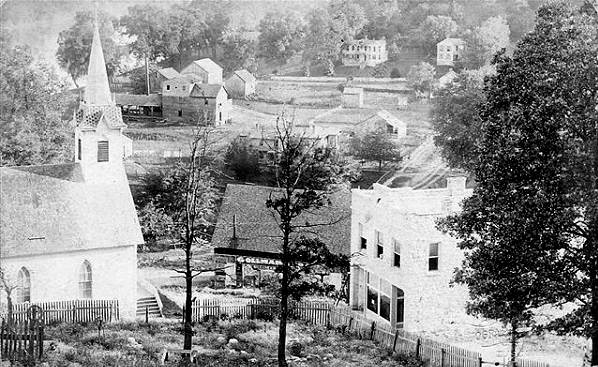
15 Presbyterian Church showing tall Steeple
This view looks down toward the bank, next door to the church, and in the valley, the Anchor Mill buildings and in the back ground the R.M. Marshall and William Hauenstein homes. In front of these two homes near the mill are the homes of Dr. McGee and the Johnson family. By the time I came along the McGee and Johnson homes were gone as well as the Anchor Mill buildings which had been moved on down the riverside to the north. Bryron Hix was the elder when I attended who rang the bell every Sunday morning. Sometimes, when I was a young boy, if we got there early enough, he would let me pull the rope which hung down through a square hole in the ceiling of the attic area of the church. The bell was placed high in the belfry above surrounded by a wooden steeple which graced the roof of the church. Byron would lift me up so I could reach high enough to grab the rope, then he would let me go; however, I wasn’t heavy enough to move the bell so he would pull the rope with me hanging on. Then when the bell rang he would let go and as the bell oscillated back to its neutral position the rope would pull me several feet off the floor.
I never got to go up into the belfry to see the bell, although you could get a glimpse of it from the ground through the open slats of the four sided belfry tower. So I was eager last week to get a close look at the bell hopefully to get some information about its maker. After we loaded the bell on the trailer I noted some words on the top of the bell which said, “Cast by H. Stuckstede and Co. St. Louis Mo. 1890” (photo 16).
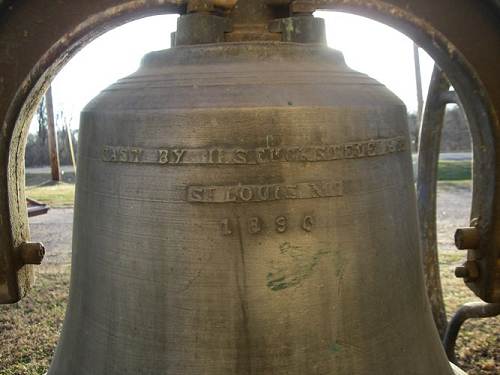
16 Cast by H. Stukestede and Co. St. Louis Mo. 1890
After learning the name of the company which made the bell, I searched the web and found this website:
https://www.gcna.org/
Summarizing the information found on the website I copied it here:
This foundry was began by J.G. Stuckstede, and operated under several different names: J.G. Stuckstede & Co. (1855-63), J.G. Stuckstede & Bro. (1863-83), H. Stuckstede & Co. (1883-1888) and The Henry Stuckstede Bell Foundry Company (1889-1931). It was the largest of several bell foundries which operated in St. Louis, and is not to be confused with Stuckstede & Bro. (1890-1961), which was operated by two nephews of Henry Stuckstede and their descendents.
The original Stuckstede foundry as noted above was begun in 1855 by Johann Gerhard Stuckstede, and was operated for several years as J.G. Stuckstede & Co. In 1863 the original partnership broke up; J.G. Stuckstede then took his much younger brother Henry as a junior partner, thus forming J.G. Stuckstede & Bro. Under this name and two later names, this foundry was probably the largest American producer of bells west of Cincinnati. More bells remain in the St.Louis region from it (at least 340) than from any other bell foundry.
The second Stuckstede foundry, now closed, was named Stuckstede & Bro., and was operated by two sons of J.G. Stuckstede (and therefore nephews of Henry Stuckstede). This foundry operated in Saint Louis, Missouri, from 1890 to 1940, and intermittently thereafter until 1961. No chimes are known to have come from this foundry, but at least 90 of its bells (mostly single but some in peals of two or three) remain in the Saint Louis region. It was the second largest of several bell foundries in St. Louis.
At least 34 different business enterprises are known to have made, sold or advertised bells in the city of St. Louis at various times during the last two-thirds of the 19th century, with a few of them lasting into the first half of the 20th century. The Stuckstede Foundry was large enough to compete with the major bell foundries to the east.
I am not completely sure how the bell was delivered to Tuscumbia but I think most likely it was by steamboat coming up the Missouri and then the Osage rivers. We do have records that indicate the Tuscumbia Christian Church, organized about the same time, had its bell delivered by steamboat.
So, next time you happen to come by the museum in Tuscumbia, take a few moments to stop and look over the newest addition to our museum: the old Presbyterian Church Bell has returned home!
A couple of weeks ago I featured fiddle player, Lyman Enloe, well known in the Miller/Cole County area for his magnificent skill at playing the old time hoe downs. This week I will continue the series of stories about local fiddle players of the past with the story of William Driver, Jr., recognized at the time as one of the all time great fiddlers to come from this area (photo 17).
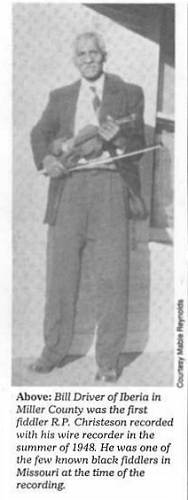
17 Bill Driver Jr.
Click image for larger view
Lewis Wall of Iberia has one of the largest collections of tape recordings of the old time Miller County fiddlers I know about (photo 18).
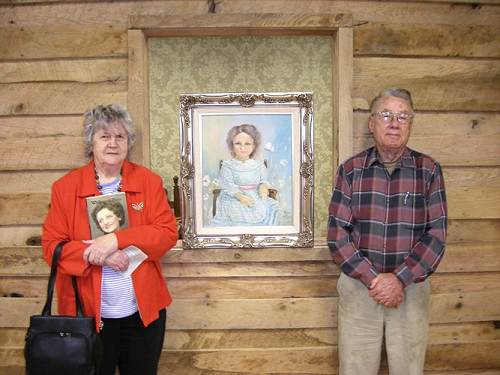
18 Helen and Lewis Wall
Many of these recordings, which now are on tape, originally were recorded from old wire recording machines. Lewis has seen perform many of these fiddle players including Bill Driver. I called Lewis the other day to ask him what he remembered about Bill’s fiddle style. Lewis told me that Bill played very fast tunes; in fact, Lewis never heard him play a slow tune. Although Bill played for many dances he preferred to play in fiddle contests as compared to those fiddlers who specialized in playing hoe downs for local dances. According to Lewis, Bill, at least, was in the top three of every contest in which he fiddled; the other two fiddlers usually being Ike Helton from east of Iberia and Henry Thompson originally from north of Tuscumbia.
Bill Driver’s story is very interesting and has been discussed by Peggy Hake on our own website which I will copy as follows here:
Peggy Hake‘s Memories of Bill Driver Jr.
I was just a small child when I last saw Bill Driver, who was a wonderful musician. Many people say he was the best musician in our part of the country. He was very much in demand and very popular at the Saturday night dances held in the Iberia area. Bill and his wife, Violet (Williams), were parents of 7 children, 6 girls and 1 boy. The father of Bill Driver was the Reverend William W. Driver, a minister who was widely known in central Missouri during the early 20th century. He was born in Jefferson City, a son of Mary Dixon, and was later adopted by a slave family named Driver. He was held as a slave during the Civil War times. Later, he moved to Laclede County, MO where he performed a commendable service to other members of his race in the surrounding area. Circa 1916, he came to Iberia and moved to a farm southwest of town near the old Oak View Church. In his obituary, his widow is not listed, but he was married at that time and had two children—William ‘Bill’ Driver of Iberia and Grace Driver Tucker of Rockford, Illinois. They had six other children, but they all died in infancy. Rev. Driver died at the age of 75 years in 1934 and his funeral service was held at the Iberia Nazarene Church with Rev. Otto Shearer officiating. He is buried in the Iberia Cemetery. Bill Driver, Jr. moved his family to the Jefferson City community where he died in the mid 1980s after reaching his 103rd birthday. His last years were spent in darkness when he lost his eyesight but I am told he could still play his beloved fiddle. Annette Driver, a granddaughter of Bill Driver Jr., owns and operates a restaurant in western Jefferson City, which has a huge clientele of patrons. Folks from near and far love the bar-b-que dishes for which the restaurant has been famous over the years.
Another narrative about Bill Driver Jr. was published in the Jefferson City Tribune by Bob Watson several years ago and is copied below:
By Bob Watson
Jefferson City News Tribune, February 19, 1995
A century ago, William Driver Jr. was a teen-ager growing up in Eldridge, a small town between Camdenton and Lebanon in south-central Missouri. As a married young adult, he and his wife, Violet Mae Williams Driver, moved to the Miller County town of Iberia. They had eight children, one boy and seven girls. Here are a couple of photographs of the Drivers’ tombtones (photos 19 and 20).
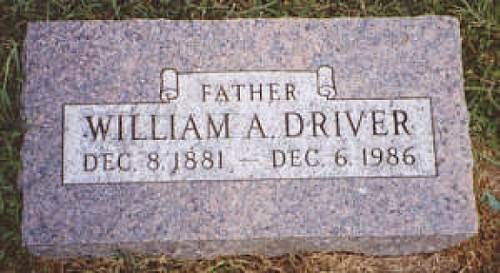
19 William A. Driver Tombstone
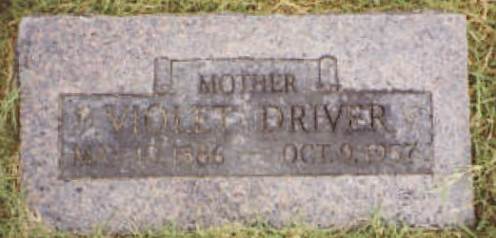
20 Violet Driver Tombstone
"They were farmers like their neighbors," said Peggy Hake, a historian and genealogist in Miller County. "I know that they were highly thought of and very well-respected. They were just down-to-earth country people who blended in with their neighborhood." They also were black. And most of their neighbors were white.
In the early 1940s-at an age when most people consider retiring-Will Jr. and Violet moved to western Cole County and worked another farm near Centertown for more than a decade before finally retiring to a daughter's home in Jefferson City. Wherever he lived, Will Driver Jr. generally was accepted and respected as a member of the community-in spite of his race-in an era when a majority of Americans considered blacks inferior to whites.
"You know, I'm sure things could have been easier and things could have been better, but it wasn't all that bad at the time," said Minnie Driver Fulcher of Jefferson City, now 73, the youngest of Will and Violet Drivers' eight children. Although she experienced racism and separation because she was black, "we didn't have any big problems with the people," she said.
The music-maker
Throughout his adult life, Will Driver Jr. made his living off the land. But he perhaps was best known as a prize-winning fiddler. "I remember when he would go to those contests and he did good," Ms. Fulcher said. "Most of the time he would always win-either first or second prize." Cash prizes often were $10, $15 or $25. "He enjoyed it. We would have these 'house parties,' as they called them in those days, and he would play music. He did a lot of that," Ms. Fulcher said.
A Driver family history, first produced two years ago by Darleen Sears Goldston, a granddaughter whose interest in the family tree has made her the Drivers' unofficial historian, said: "Bill Driver's musical ability included: playing the piano, organ, fiddle, guitar, banjo, mandolin and harmonica; all very well. In fact, he played in many musical contests and quite often won first prize."
Grandson Ronnie Fulcher, now 54, spent a lot of time with his grandfather, Will Driver Jr., who was 104 when he died in 1986. Fulcher said one memory of his grandfather that stands out "is late at night, with him sitting out on the porch playing the fiddle and then getting comments from people from miles away, who would say, 'Late at night, we could hear him playing.' "You're talking 11, 12 o'clock at night, after working all day" on the farm near Centertown, Fulcher said.
Over 11 years ago, Ann Jenkins and historian Gary Kremer wrote an article for Missouri Life magazine about the town of Eldridge: "In fact, one of the most frequently mentioned 'good memories' recalled by blacks and whites alike was one of integrated community picnics that featured the fiddling of black musician Will Driver, son of the minister."
"No one we talked to failed to mention Will Driver," they wrote. "Driver has been called by one student of fiddle music 'the best example I encountered of a repertory strictly indigenous to a local area.'"
Annette Driver, now 38, a great-granddaughter, remembers occasional visits with him at their east-side Jefferson City home. However, she rarely heard him play music. But she remembers him as a man with a strong dedication to his family, and she wants others to remember her ancestors in the same way. To grandson Ronnie Fulcher, Will Driver Jr. 'was just a very cordial. stalwart, sensible individual, who seemed to always find a way to make things work for you."
Jefferson City roots
Will Driver Jr. was born December 8, 1881, in Eldridge, the town in northern Laclede County named for the general store it grew up around. (The store was founded by Alfred Eldridge, a black farmhand who decided there were enough people living in the area to warrant opening a general store. Kremer and Ms. Jenkins wrote in 1983.)
Will Jr.'s parents were William Anderson Driver Sr., a Baptist minister, and Susan Shipley. Will Jr. and his sister, Grace were the only two of the couple's eight children who survived into adulthood.
Will Driver Sr. was born of slave parents in Jefferson City. His birth name, gleaned from official records, was Frank Crawley. For reasons the family hasn't yet learned, Ms. Goldston said he was adopted and raised by William and Jane Driver, although a sister remained in Jefferson City with their parents.
Will Driver Sr. was considered a "prominent community leader" in Eldridge, Kremer and Ms. Jenkins wrote. "Driver served the black community as a minister and often preached to his congregation in the same church used by whites."
Minnie Mae (Fulcher) Driver
Minnie Fulcher (photo 21) remembers some of his sermons as being the inspiring, almost fire-and-brimstone type. "I remember him building what we called then the brush arbor-like a church in the fields," she said.
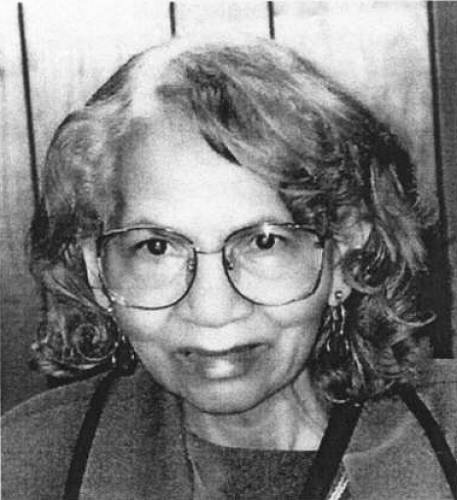
21 Minnie May Fulcher Driver
But there was more, said her son, Ronnie Fulcher. Will Jr. said his grandfather reported "that (his father) not only was a minister, but a traveling salesman selling organs from the back of a wagon, traveling through central Missouri."
Ms. Hake, the Miller County historian, said she had heard that story. "I know he was a traveling evangelist," she said. "I would say that perhaps (the salesman) would be a little unusual.
Integration in Mid-Missouri
What may seem unusual to many in today's world was the general acceptance the Drivers and many of their black friends and neighbors had among white neighbors. Black communities dotted the landscape, Ms. Hake and Kremer said. Former slaves who left the South in droves after the Civil War stopped along the way when they found land they could buy and farm or when their money ran out. A number of all-black or integrated communities sprang up around those new farms, in areas that now mostly are all white.
"Both blacks and whites who lived together in Eldridge for the first forty years of the twentieth century remember that racial friction was relatively rare," Kremer and Ms. Jenkins wrote in the 1983 article. Kremer and Ms. Hake both say they're considering books on the history of some of those towns in rural Missouri.
Even in the 1940s and '50s-a time when racism was becoming a major national issue and the South was a growing hotbed of confrontation and violence-Ronnie Fulcher said, "I can even remember getting on the wagon (and) driving into Lohman and buying victuals or supplies." While in town, his grandfather would stop by the local tavern and visit with others while drinking "two or three beers," Fulcher said. "There was no major hullabaloo about them coming into the place.
Segregation
But that kind of integration wasn't total or legal. State laws required black and white children to be educated in separate schools-and state aid wasn't given if the school population dropped below eight students. As the Industrial Revolution attracted more families to the cities and away from farms, many schools-especially those for blacks-closed. The lack of local education drove more families to move to larger cities, where more schools were available and the downward spiral continued.
Will Driver Jr., for example, went to school in Lebanon, 15 miles from his birthplace. And in Iberia, Ms. Hake said, "by the time the Driver children were of school age…they were probably the only black children left. So…their mother taught them at home.
Preserving history
Darleen Goldston began her history of the Drivers as a way to preserve her family's past. She distributed the first copies of her booklet at a family reunion. "If we don't start putting things down," she said, "all of our history will be lost."
Dr. William Ross, president of the Jefferson City chapter of the National Association for the Advancement of Colored People, said more families should preserve their history. "You look back to see what their life was like," he said. "This motivates you to do better in your own life."
Ross, Ms. Goldston and Ronnie Fulcher all worried about the effect of modern society on families' efforts to tract their roots. But Fulcher said he's learning something from his study, and his memories of Will Driver's life.
"I think what you see in my grandfather and his father are individuals whose character and skills and abilities maybe stood out a little more than the rest," he said. Will Jr. is "a perfect example of making something meaningful out of your life in spite of restrictive conditions," Fulcher said. "He took what the world gave him at that time."
"And, as best as he could see it, he made a meaningful life out of it that was a productive life, that was a helpful life and that resulted in that people who knew him, from all races, respected him."
Williams Slave Cabin
This is the slave cabin where Violet Mae Williams Driver was born (photo 22). It was moved to the Miller County Historical Society from the Williams farm outside Iberia.
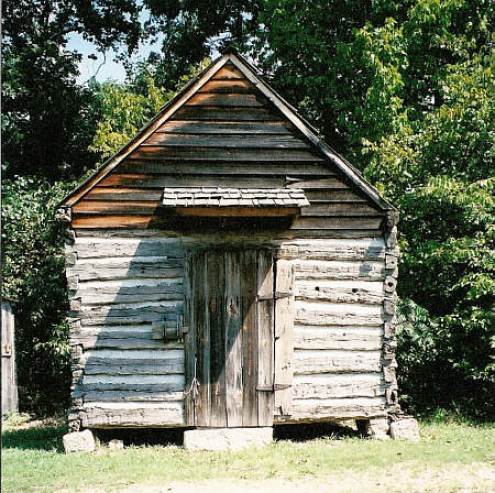
22 Williams Slave Cabin
Sylvia Brinkman (photo 23) is another Miller Countian who remembers Bill Driver Jr.
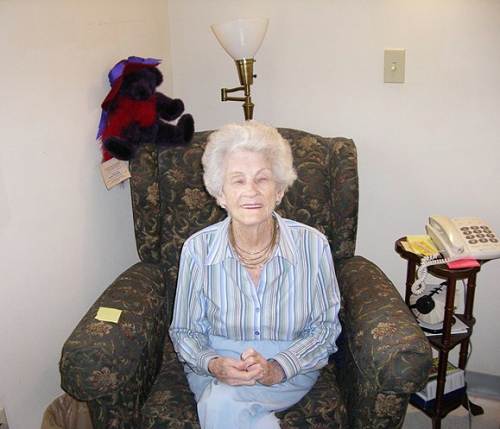
23 Sylvia Pierce Brinkman
Sylvia was the daughter of William Daniel Pierce and Sarah Elizabeth (Roberts) Pierce and was born and raised in Eugene, Missouri. Although her parents came from south of the Osage River, her father moved to Eugene to work on the tunnel being constructed for the railroad which was being built through Miller County in the 1880’s. She was born on a farm four miles south of Eugene in 1913, seventh of thirteen children, all of whom are now gone.
Last year I visited Sylvia at the Miller County Rehabilitation Center where she then resided at which time she related to me several early memories of her childhood on the farm near Eugene. For example, she loved to dance the jig to fiddle tunes. One day when Sylvia was five years old, she went to Eugene with her family at the same time that Bill Driver was fiddling on a street corner in front of Schell’s General Store. Sylvia could not keep from doing a jig dance which everyone around began to notice and enjoy. One of the men passed a hat into which passersby dropped a penny or two, enough that Sylvia was able to buy herself a pair of new shoes in Schell’s store. Sylvia said she didn’t know if it were her dancing or Bill’s playing which caused so many people to drop coins into the hat. We both surmised probably it was just a tribute to each of them that they were so successful that day!
If you would like to hear some really old recordings given me by Lewis Wall of Bill Driver Jr. playing his fiddle, just click on the links below (audio files are in the MP3 format):
Also, you may be interested in reading the history of Bill Driver’s wife, Violet Williams, who was the grand daughter of Chaney Williams, a slave brought to Miller County with her daughter Easter (mother of Violet), by John Williams whose farm was located four miles west of Iberia. These stories are told at these two locations on our own web site:
http://www.millercountymuseum.org/archives/080811.html
http://www.millercountymuseum.org/bios/bio_black.html
You will need to scroll half way down the page of each of the above websites to get to the sections about the Williams family.
Last August we were very happy to have a special visitor to the museum, Clarence “Juny” Driver (photo 24), great grandson of Bill Driver Jr.
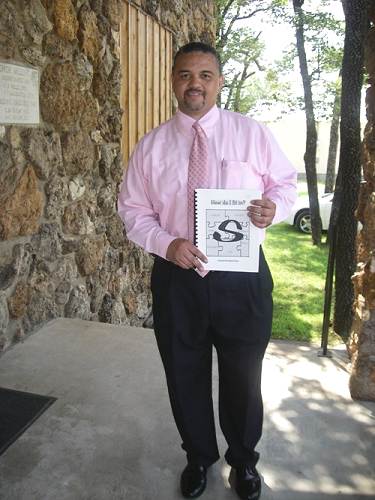
24 Clarence Juny Driver Jr.
I am copying below the story of Juny’s visit from the Progress Notes of August 18, 2008, the day he visited:
“We were very happy last week to meet at the museum Darryl Clarence “Juny” Driver Jr. of Jefferson City.
Clarence is the great grandson of William Driver, the famous Miller County fiddler who won many fiddling championships locally during the 1920’s and 30’s and 40’s, and the great great grandson of Easter Williams, who long ago had lived in the small cabin now located on our museum grounds. Clarence’s family is the one to which Sue Steen Cates referred in her narrative last week which told the history of the small cabin. If you didn’t read it I suggest you look it up in the August 11, 2008 edition. In the photo, Clarence is holding the book Sue wrote which contained the history of Clarence’s family in Miller County.
Clarence is an attorney with the firm of Hanrahan Trapp of Jefferson City and was in Tuscumbia doing some research in preparation for an upcoming hearing at the courthouse involving one of his clients. On his way home he decided to stop by the museum since he was aware of his family’s roots in Miller County. Because he was very good friends in school at Jefferson City with my wife Judy’s nephew, Brent Gardner, she recognized Clarence and immediately referred to him by his nickname “Juny” which clued him that we were familiar with him and his family’s roots here. Clarence was very pleased to know that we plan to feature his great grandfather, William Driver, in our musical display, due to his fame as one of the county’s best fiddle players. As I indicated last week, you can read about the Driver family as well as other black families of Miller County’s history on our website as recorded by Peggy Hake. Go to the following URL and scroll down the page until you get to the section about the Driver family:
http://www.millercountymuseum.org/bios/bio_black.html”
One final note about the Driver family is a sad one. One of Bill and Violet’s babies died in infancy. Having no place to bury the infant, they chose a place behind the Oak View Church (photo 25) which now is almost completely hidden from the highway by overgrowth of woods and brush.
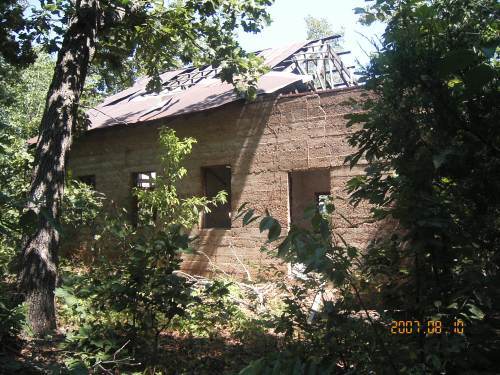
25 Oakview Church
For many years the grave was maintained by the Drivers’ and after their death by neighbors. Lewis Wall took me over to the site last summer and a bare outline of the grave is still present, although not well seen in the photo (photo 26).
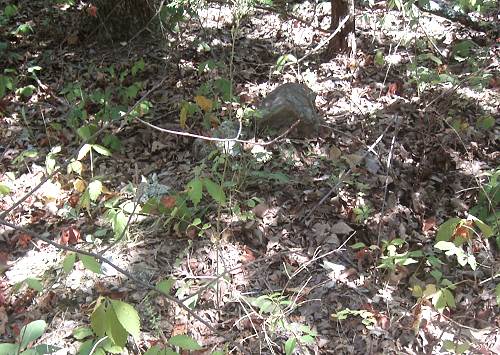
26 Driver Infant Grave Site - Headstone
For many years a small cross was driven in the ground but it no longer was present the day we were there.
The Jefferson City News Tribune ran an interesting article about old time fiddling Sunday, November 30, 2008. Thanks go to David Statler and Doris Wiggins who alerted me to it.
This article also lists an interesting website regarding Wyatt’s Violin Shop in Independence, Missouri at:
https://www.wyattviolin.com
Ellis Bray of Eldon, local author and historian, also is an expert regarding Indian artifacts and culture. He has been helping us lately to identify and catalogue our Indian artifact display. I had opportunity to talk to him recently when he was at work in our museum Indian display identifying and labeling some of the many items in the collection (photo 27).
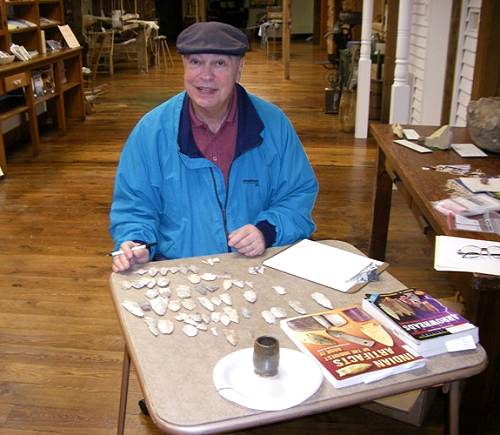
27 Ellis Bray
The Indian artifacts have come from several different sources over the years, most recently, Alton Davis, of Eldon. Ellis is going to write a summary describing each of our artifacts regarding their significance and use in the local Indian culture of nearly two hundred years ago. When that is finished we will place it on our website. In the meantime, I photographed a couple of the items he had just finished labeling the other day.
The first one is a flint hand tool for chiseling (photo 28).
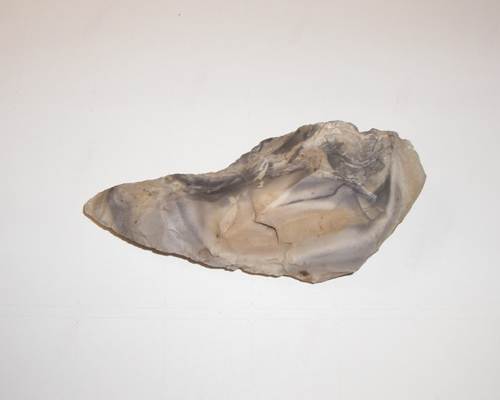
28 Chisel
While it may be difficult to see from the photograph, the chisel has grooves for the thumb and three fingers such that it is “nonslip.” A novice might not have noticed this type of detail; in fact, a novice might not even have recognized this piece of rock as being an Indian tool to begin with if it were seen lying on the ground.
The second artifact is a tool used for grinding grain into flour or meal such as would be described most fittingly as the pestle of a pestle and mortar (photo 29).
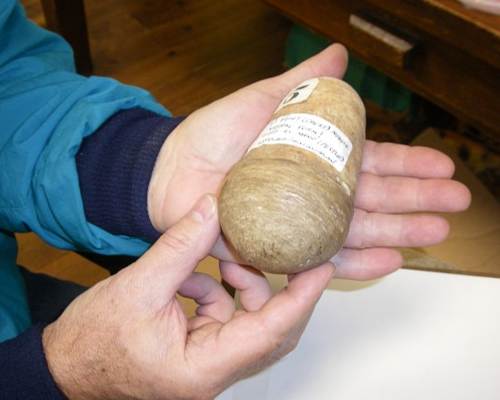
29 Pestle
Ellis will be working off and on through the winter but by spring time we hope to have our Indian artifact display organized to the place that all items are identified with their use described.
Notice:
Our Christmas pot luck dinner is scheduled for this coming Sunday, December 14 at 1:00 p.m. All are invited. The Christmas decorations are in place and entertainment will be provided by our local singing artist, Frank Schlesinger (photo 31).
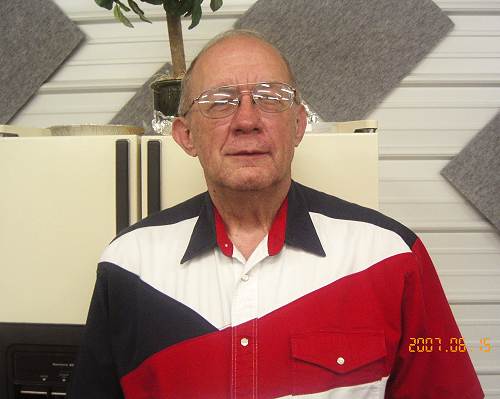
31 Frank Schlesinger
Frank is a talented vocalist who has a style of singing which is captivating and very entertaining. You won’t want to miss this opportunity to hear him!
That's all for this week.
|



